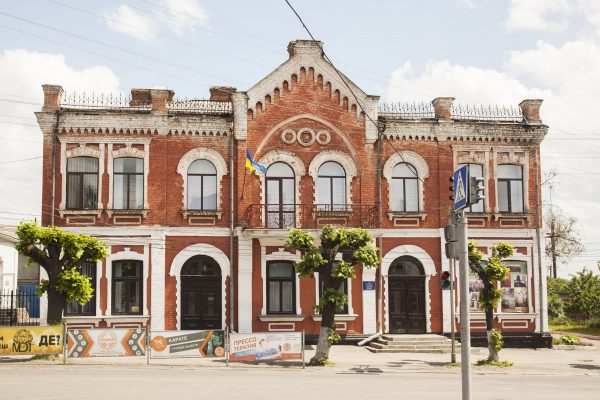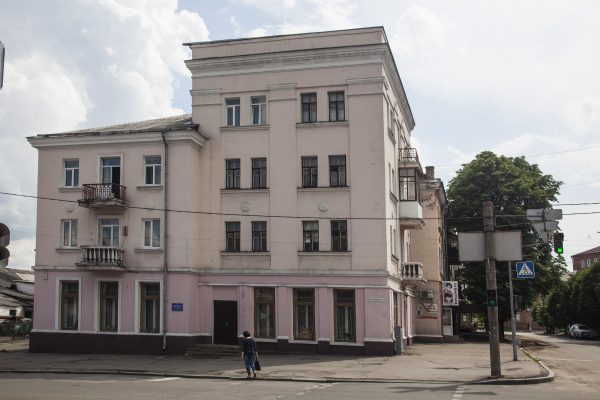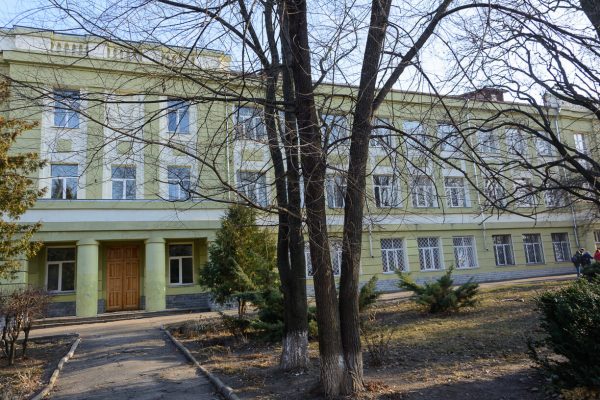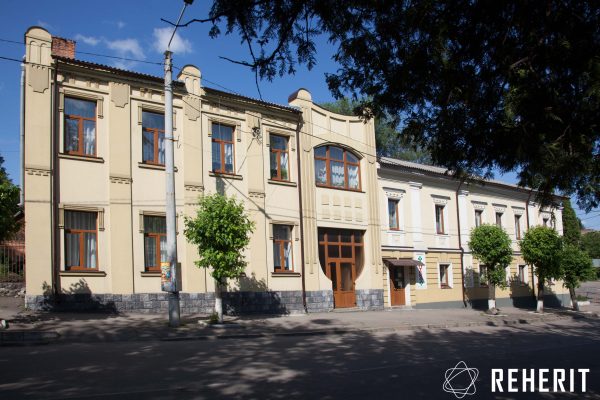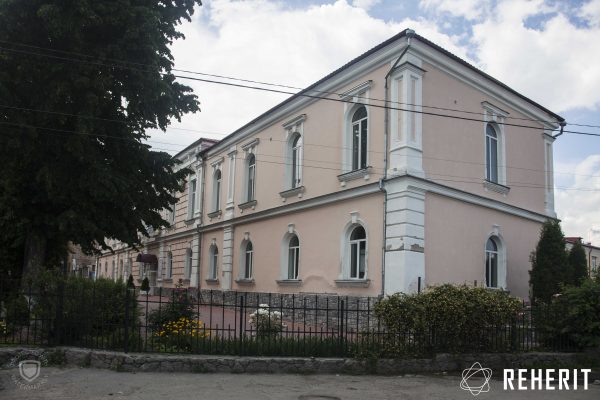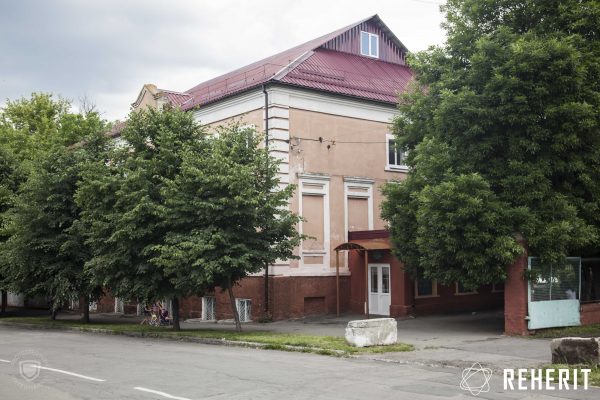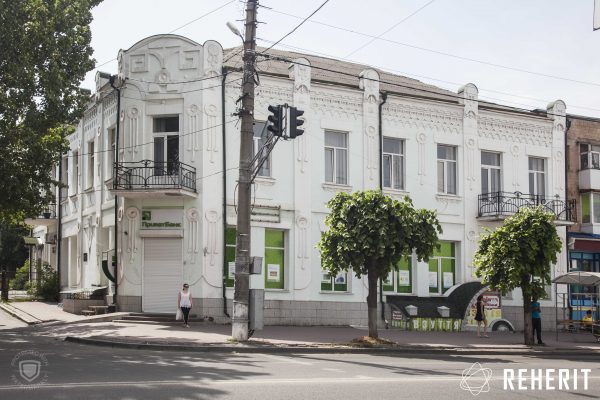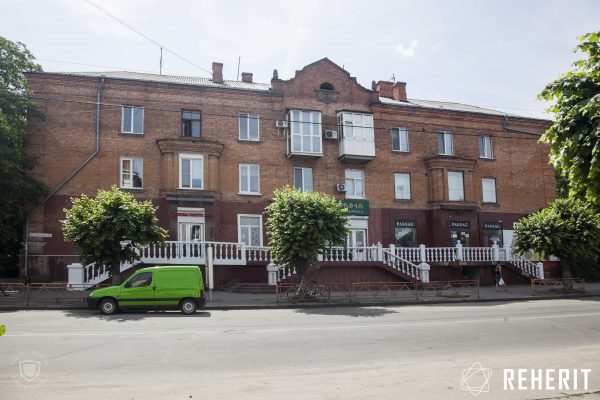English below ↓
Ця красива будівля в центрі Умані – не лише місце розташування однієї з найпрестижніших місцевих шкіл. Це пам’ятка, що розповідає особливу історію – історію про здобуття жінками нових прав і можливостей і про те, що цей шлях не був коротким і прямим.
Жіночу гімназію в Умані почали будувати у 1900 році, у вересні 1901 році класні кімнати відкрили для дівчат. Умань тут не була першопрохідцем. У Російській імперії перші жіночі гімназії з’явилися наприкінці 1850 – початку 1860-х років, спершу в столичних та великих губернських містах (напр., у Києві – в 1860 році, у Катеринославі – у 1865 році, в Одесі – у 1868 році), а вже потім у повітових. Великий попит на навчання дівчат засвідчив важливу зміну в суспільній свідомості: до жіночої освіти стали ставитися позитивно. В минуле поступово відходило уявлення про те, що навчання шкодить жінці, применшує її чарівність та відволікає дівчат від “природного призначення” – народжувати дітей і дбати про родину. Очевидною для суспільства й уряду стала і незадовільність домашньої освіти або приватних закритих жіночих пансіонів, звідки дівчата подеколи виносили лише вміння модно вдягатися і манірно поводитися (тут можна згадати відомий карикатурний портрет Проні Прокопівни з п’єси “За двома зайцями” Михайла Старицького). Розширення мережі гімназій забезпечило дівчатам доступ до середньої освіти. Водночас поділ гімназій на окремі для юнаків та дівчат усе ж свідчив про те, що про абсолютну рівність прав на освіту не йшлося. Юнаків та дівчат виховували окремо згідно з чітким уявленням про належні чоловічі і жіночі ролі.
Жіноча гімназія в Умані відкрилася порівняно пізно і тому, що в Російській імперії обов’язок утримувати навчальні заклади було покладено на міську владу. Відшукати кошти на будівництво гімназії Міська дума Умані змогла лише на межі ХІХ – ХХ ст. Для цього з аукціону під забудову продали частину землі однієї з центральних міських площ, передбачався і продаж частини міськогогаю – “Грекового лісу” на вирубку. Фасад новозведеної гімназії був декорований т. зв. “російським візерунком”, виконаним цегляною кладкою. Будівля планувалася спеціально для потреб жіночої освіти: коридорну систему тут було замінено системою центральних залів. Їх використовували для зібрань та уроків танців. Грати на фортепіано і танцювати у великій залі дівчат заохочували і на великій перерві. Це була одна з найулюбленіших розваг гімназисток.
Про те, що відкриття гімназії було в Умані на часі, свідчила її популярність. Вже в перші роки тут навчалося близько 400 учениць. На 1904 році жіноча гімназія мала повний склад учнів – всі сім класів і один підготовчий. Аби дати можливість вчитися усім охочим, у 1913 році гімназію було розширено: під класи віддали приміщення третього поверху будівлі Міської думи. У 1914-1915 роках відкрився спеціальний 8-ий клас – дівчата, що його закінчували, здобували фах домашньої наставниці.
Подібно до інших жіночих гімназій Російської імперії, уманська гімназія була відкритою для дівчат усіх станів та усіх віросповідань. Статистика про учениць 1912– 1913 років малює картину багаторелігійного міста, яким була Умань: з 337 учениць православними були близько 69%, 19% дівчат сповідували юдаїзм, римо-католицизм – близько 11% учениць. Надія Суровцова, яка навчалася в гімназії у 1906-1912 роках і залишила детальний опис життя і побуту учениць, пригадувала, що тут разом вчилися росіянки, українки, єврейки, польки, було кілька німкень, уроки “Закону Божого” окремо викладав православний священник та римо-католицький ксьондз. Тут могли навчатися не лише дворянки, але і доньки чиновників та офіцерів, священників, купців, ремісників і заможних селян (у 1912-1913 роках дівчата з міщанських родин складали 35,3%, з чиновницьких родин – 28%, з дворянських – 12%, з родин селян – 10%, з родин священників – 9%). Водночас відкритість гімназії не варто переоцінювати. Оскільки навчання було платним, доньки незаможних батьків були радше винятком. При гімназії діяло спеціальне товариство допомоги незаможнім ученицям, яке влаштовувало благодійні вистави, вечори та концерти на їхню користь.
Програма навчання у жіночих гімназіях Російської імперії за своїм змістом загалом наслідувала програми чоловічих гімназій, більшість предметів тут співпадали. Водночас вона була частково полегшеною: дівчатам менше і поверховіше викладали природничі науки та математику. Окрему увагу приділяли предметам, які вважали важливими саме для жіночої освіти – їх опанування мусило дозволити жінці вільніше почуватися в товаристві, а також бути господинею в домі. Йдеться про танці, співи та музику, і, звісно ж, рукоділля. Випускниці гімназії, навіть із заможних родин, вміли вправно вишивати, в’язати та були готові шити одяг, передусім дитячий і жіночий.
Опікувалися тут також вихованням таких важливих “жіночих чеснот”, як чемність, охайність та стриманість. Рівень контролю за поведінкою учнів середніх навчальних закладів в Російській імперії загалом був високим, але особливо вимогливою шкільна адміністрація зазвичай була саме до дівчат. Тут за дотриманням правил “доброго тону” стежили особливо ретельно. Зухвальством, вартим покарання, був відступ від вимог щодо навчальної форми. Гімназистки в Умані носили скромну повсякденну коричневу форму із чорними фартушками, до кіс заплітали чорні стрічки. До кожного класу була прикріплена класна дама, обов’язком якої було стежити за поведінкою учениць як на уроках, так і поза гімназією. Оцінка за поведінку тут була не менш важливою за оцінки з базових предметів. Надія Суровцова у спогадах писала: “Що вважалося тоді поганою поведінкою? Зухвала відповідь, недбалий уклін на вулиці, поява після восьмої години вечора, відвідини кіно без дозволу, зайвий гребінець у косах, забутий удома зошит, списування під час письма, підказування, бійки (хоч це бувало дуже рідко), спізнення на молитву...”.
Важливим був також ідеологічний компонент освіти: гімназії мусили виховати не лише дисципліновану, обізнану з добрими манерами, але і вірнопіддану та патріотичну жінку. Щоденно гімназистки читали молитву за царя. У 1913 році жіночій гімназії в Умані присвоєно ім’я великої княгині Євдокії Суздальської з нагоди святкування 300-річчя дому Романових (княгиня, заміжня за Дмитром Донським, уславилася не лише своєю побожністю, але і тим, що була люблячою та відданою дружиною). У роки Першої світової війни при гімназії було створено комітет з виготовлення білизни для солдатів діючої армії.
Які можливості давало дівчатам Умані навчання в гімназії? Це передусім хай і обмежені, проте нові перспективи самореалізації. Випускниці отримували право ставати домашніми вчительками та вчительками початкових класів у народних училищах. Хоча йшлося про ніби традиційну для жінки роль – виховательки дітей, праця вчительки передбачала долучення до світу інтелектуальної праці і також дозволяла самостійно заробляти на життя. Розширення мережі жіночих гімназій і збільшення кількості освічених випускниць дозволяли гостріше ставити питання про доступ жінок до вищої освіти та сфер праці, де раніше діяли виключно чоловіки. Серед відомих випускниць уманської гімназії були письменниця й громадська діячка Надія Суровцова, скульпторка Галина Петрашевич, професорка Київського медичного інституту, членкиня-кореспондентка Медичної академії наук СРСР, фахівчиня з педіатрії та винахідниця замінника материнського молока Олена Хохол.
Після 1917 року колишня гімназія залишилася навчальним закладом, проте зміст та пріоритети освіти якісно змінилися. Дівчата та хлопці стали вчитися разом, за однаковими програмами, у яких особливий наголос було зроблено на професійно-технічну складову навчання. З 1920 року у будівлі діяла трудова школа, у 1926 році вона отримала ім’я Івана Франка. З 30-х до кінця 80-х років (з перервою часу німецької окупації 1941–1943 років, коли тут розташовувався шпиталь) тут була середня загальноосвітня школа, у якій подеколи запроваджувалися експерименти зі спеціальної підготовки до робітничих спеціальностей. На початку 1970-х років тут діяв клас із поглибленим вивченням математики, що сприяло зростанню престижності школи.
Після 1991 року навчальний заклад знову був переорієнтований: тут зосередилися на загальній гуманітарній підготовці та естетичному вихованні. Привабливим видавалося повернутися до дореволюційної назви: з 1990 році при школі відкрито перший “гімназійний клас”, 1992 року – школу мистецтв, з 1999 року школа стала міською гімназією. У 2020 році Уманська міська гімназія – школа естетичного виховання посіла перше місце у рейтингу шкіл Черкаської області.
Сьогодні будівля – це пам’ятка непростих трансформацій освіти, вражаючого перетворення із платної жіночої гімназії на загальноосвітню трудову школу, середню школу з орієнтацією на робітничу спеціалізацію випускників і нарешті на початку ХХІ століття – на престижну міську спеціалізовану гімназію.
АВТОРКА ТЕКСТУ: Тетяна Портнова.
АРХІВНЕ ФОТО: Уманський краєзнавчий музей.
Уманська жіноча гімназія є одним з 10 об'єктів, ознакованих в Умані у ході реалізації проекту ReHerit. Об'єкти актуалізують теми, місця та імена спільної спадщини міста. Детальніше про маршрут та інші його об'єкти за посиланням.
Uman Women’s Gymnasium
Uman City Gymnasium.
5, Andrii Kyzyl St.
This pretty building in the center of Uman is not only the location of one of the most prestigious local schools. It is also a landmark that tells a special story – the story of women gaining new rights and opportunities, and how this path was neither short, nor straight.
Construction of the Women’s Gymnasium in Uman started in 1900; classrooms opened to the students in September 1901. Uman was not the first in this endeavor; the earliest women’s gymnasia in the Russian Empire appeared in the late 1850s and early 1860s, initially in capital and large Governorate cities (e. g. Kyiv in 1860, Katerynoslav in 1865, Odessa in 1868). Only later did such schools open in smaller district towns. The high demand for women’s education spoke to a major shift in the public consciousness: women’s education was now seen as a boon. Gone, or at least on its way out was the idea that education is of no use to a woman, that it diminishes women’s charm, and distracts girls from their “natural calling” – to give birth and take care of a family. No less clear to society and government alike was the inadequacy of homeschooling or private closed women’s finishing schools, which often taught young women little more than fashion sense and affected behavior (playwright Mykhailo Starytsky provided commentary on this through the caricature character of Pronia Prokopivna from his well-known 1883 play Za dvoma zaitsiamy (“Chasing Two Hares”)). A broader network of gymnasia provided girls with access to secondary education. At the same time, the segregation of schools into men’s and women’s attests to the fact that full equality was not yet the objective. Young men and young women were educated separately, according to clear ideas about men’s and women’s proper roles.
The women’s gymnasium in Uman opened comparatively late also because it was the local authorities that were charged with maintaining educational institutions in the Russian Empire. Uman’s city council only managed to procure funds for the construction of the gymnasium at the turn of the 20th century. To this end, a part of one of the central squares was auctioned off (the city also intended to sell part of a park, the “Greek’s Forest” for felling). The new gymnasium’s facade was decorated with so-called “Russian ornament” laid in brick. The building was planned with women’s education in mind: a corridor network here was replaced with a system of central rooms. These were used for assemblies and dance lessons. Girls were encouraged to play the piano and dance in the great hall during “long recess”. This was a favorite pastime among the gymnasium’s students.
The gymnasium’s popularity was a sign that its opening in Uman was long due. Already in its first years, the gymnasium had about 400 students. By 1904, the women’s gymnasium had a full student body – all seven years, plus a preparatory year. In order to provide all candidates with the opportunity to study here, the school was expanded in 1913: the third floor of the building of the City Duma was given over for classrooms. In 1914-1915 a special 8th year was introduced, whose graduates received the certification of governess.
Like other women’s gymnasia of the Russian Empire, the Uman Gymnasium was open to girls of all estates and religions. Student statistics from 1912-1913 paint a picture of a multireligious city: about 69 per cent of the school’s 337 students were Orthodox Christian, 19 per cent were Jews, about 11 per cent were Roman Catholic. Nadia Surovtsova, who was a student at the gymnasium in 1906–1912, left behind detailed descriptions of student life. She mentioned that the school had Russian, Ukrainian, Jewish and Polish, as well as a handful of German girls all studying together. Religion was taught separately by an Orthodox priest and a Roman Catholic one. The school was open not only to nobility, but also to daughters of officials and military officers, merchants, craftsmen and wealthy peasants (in 1912–1913, 35.3 per cent of girls came from bourgeois families, 28 per cent – from families of various officials, 12 from the nobility, 10 from peasant families, and 9 from families of the clergy). At the same time we should be careful not to paint too optimistic a picture of the school’s openness. Because instruction was paid, daughters of parents of modest means were rather an exception. The gymnasium did have a special support society for poorer students, which put on charity plays, soirées and concerts to benefit them.
The curriculum in women’s gymnasia of the Russian Empire largely followed that of men’s gymnasia, with most subjects coinciding. At the same time, it was somewhat less rigorous: there was less instruction in the natural sciences and mathematics, and not quite at the same level. Special attention was given to subjects seen as important for women’s education – a mastery of these was seen as necessary for a woman to feel comfortable in society, and to be “the lady of the house.” These included dancing, singing and music, and of course needlework. The graduates, even ones from wealthy families, were skilled at sewing, knitting, and would have been able to make clothing, particularly children’s and women’s clothing.
The school also took it upon itself to inculcate “feminine virtues,” including politeness, neatness and restraint. The level of control over the behavior of students in Russian Imperial secondary educational institutions tended to be high in general, but school administrations were usually especially demanding of girls. There was particular attention to “good manners.” School uniform violations were seen as insolence deserving of punishment. The Uman Gymnasium girls wore everyday brown uniform with black aprons and with black ribbons in their braids. Every class had a class mistress, whose responsibility it was to watch the students’ behavior both in class and outside of the gymnasium. Good behavior grades were seen as no less important than grades in basic disciplines. In her memoirs, Nadiya Surovtsova wrote: “What was seen as bad manners then? An insolent reply, a careless bow in greeting, showing up after eight in the evening, visiting the cinema without leave, extra combs in the hair, a notebook forgotten at home, cheating in class, or aiding cheating, fights (those these were very rare), being late for prayer...”.
Equally important was the ideological component of schooling: gymnasia were supposed not only to educate disciplined, well-read, and well-mannered women, but also women who were loyal and patriotic. There was daily prayer for the Tsar. In 1913, on the occasion of the 300th jubilee of the House of Romanov, the Uman Gymnasium was given the name of Great Princess Eudoxia of Suzdal (this Princess, wife of Dmitri Donskoy, was known not only for her piety, but also for being a loving and loyal wife). In the years of the First World War, the gymnasium had a committee for sewing linens for soldiers of the standing army.
What opportunities did a gymnasium education offer to girls of Uman? Although limited, there were some prospects for self-actualization. The graduates had the right to become governesses and elementary school teachers. Although at first glance this meant a traditional role – that of teaching children – the work of a teacher implied participation in the world of intellectual work, and also provided the opportunity to make a living. The expansion of a network of women’s gymnasia, and the higher numbers of educated graduates, put the questions of women’s access to higher education and traditionally masculine fields in sharper relief. Among the Gymnasium’s famous graduates were writer and civic activist Nadia Surovtsova, sculptor Halyna Petrashevych, as well as Olena Khokhol, professor of the Kyiv Medical Institute, corresponding member of the Academy of Medical Sciences of the USSR, podiatrist and inventor of a breast milk replacement formula.
After 1917 the former gymnasium retained its function, but there was a qualitative change in the content and priorities of instruction. The school now taught both girls and boys, according to the same curriculum with a special focus on professional and technical disciplines. From 1920 onwards the building housed a labor school, in 1926 it was given the name of Ivan Franko. From the 1930s until the late 1980s (with a break in the years of the German occupation, when it was a hospital), this was a secondary school, which sometimes introduced experiments in specialized education for workers. In the early 1970s the school had a class with a heavier focus on mathematics, which increased the institution’s prestige.
After 1991, the school reoriented again: it now offered a general humanities and aesthetic education. A return to the pre-revolutionary name seemed attractive: starting in 1990 the school opened its first “gymnasium class,” in 1992 it started a school of arts, and from 1999 onwards it has been known as the City Gymnasium. In 2020, the Uman City Gymnasium and School for Aesthetic Education took first place in a ranking of schools of the Cherkasy region.
Today the building commemorates the convoluted transformations of education, a striking metamorphosis from a private, paid women’s gymnasium to a secondary work school, training its students in workers’ trades, and finally in the early 21st century – to a prestigious specialized gymnasium.
TEXT BY Tetiana Portnova
ARCHIVAL PHOTOGRAPHY FROM THE Uman Local History Museum
This text is an extended description of an object marked in the urban space as part of a project dedicated to marking ten objects of cultural heritage. You can learn more about the projects and find links for the other 10 objects here.

